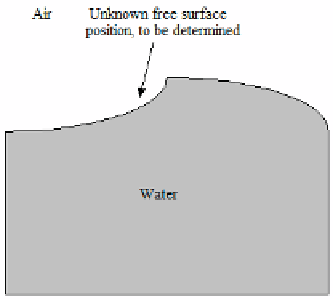Geology Reference
In-Depth Information
3.3 Example 3-3. Gravity-Capillary Waves in Deep Water
We have encountered wave phenomena hosted by different formulations,
e.g., the classical equation
2
u/ t
2
- c
2 2
u/ x
2
= 0, the fourth-order beam
equation A
2
v/ t
2
+ EI
4
v/ x
4
= 0, and the three-dimensional acoustic
model
2
p/ t
2
- c
2
(
2
p/ x
2
+
2
p/ y
2
+
2
p/ z
2
) = 0. Their respective dispersion
= (EI/ A) k
2
, and
2
/c
2
= k
x
2
+k
y
2
+k
z
2
, represent
relations, i.e.,
= c k,
contrasting results.
Here, we will consider the propagation of gravity-capillary waves in deep
water, as shown in Figure 3.3, a problem that is important in evaluating ocean
wave loads on offshore platforms. We will demonstrate how wave-like
solutions to
elliptic
equations like
2
/ x
2
+
2
/ y
2
= 0 arise (general solutions
to such equations take the form (x,y) = f(x+
i
y) + g(x-
i
y)) - a particularly
interesting example since elliptic equations are definitely not hyperbolic!
However, wave-like motions
are
made possible by special “free surface”
boundary conditions. For readers new to hydrodynamics,
gravity waves
are
those dominated by
gravity
or weight;
capillary waves
are, by contrast,
controlled by
surface tension
. We introduce the basic concepts here, but more
details are offered later. A classic hydrodynamics reference is Lamb (1945).
Figure 3.3.
Water waves with free surface.
3.3.1 Governing Laplace equation.
We consider incompressible wave motions in constant density water; these
exclude sound effects (which would arise from fluid compressibility) and also
density stratification effects (associated with nonuniformly dissolved salt).
Since the density
in the mass conservation law
/ t + ( u)/ x + ( v)/ y =
0 is constant, we have
u/ x + v/ y = 0
(3.62)

































Search WWH ::

Custom Search